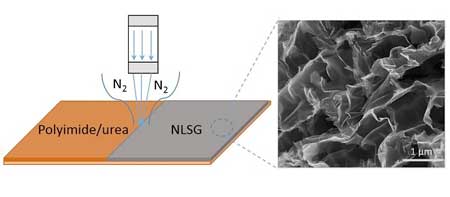| Jul 30, 2018 | |
Lasers write better graphene anodes(Nanowerk News) Sodium-ion batteries have potential to replace the currently used lithium-ion batteries by using the cheaper (less than a thirtieth of the cost of lithium) and more abundant sodium resource. This has particular potential in Saudi Arabia, where sodium is readily available and easily extracted as a byproduct of water desalination, a significant source of potable water in the country. |
|
| Yet normal graphite, the dominant anode material in lithium-ion batteries, struggles to store or intercalate sodium ions because sodium ions are larger than lithium ions. Hard carbon is a type of disordered graphite that can store more sodium ions, hence increasing battery capacity. The problem is that making hard carbon requires temperatures of almost 1000°C. | |
| The King Abdullah University of Science and Technology (KAUST) team led by Husam Alshareef has developed a process using a simple bench-top laser to make three-dimensional hard carbon directly on copper collectors without excessive temperatures or additional coating steps (Advanced Energy Materials, "Highly-doped 3D graphene Na ion battery anode by laser scribing polyimide films in nitrogen ambient"). | |
 |
|
| The laser light converts a polyimide–urea polymer into three-dimensional hard carbon (right). (© Wiley) | |
| The team formed a polymer (urea-containing polyimide) sheet on copper and then exposed this sheet to strong laser light. By introducing nitrogen gas during the process, the team could replace some of the carbon atoms with nitrogen atoms, reaching an extremely high nitrogen level (13 atomic %), which is unattainable by other techniques. Thus, the three-dimensional graphene was more conductive, had expanded atomic spacing, and was directly bonded to the copper current collectors, eliminating the need for additional processing steps. | |
| “We wanted to find a way to make three dimensional hard carbons without having to excessively heat our samples. This way we could form the hard carbon directly on copper collectors,” said Fan Zhang, a Ph.D. student in Alshareef’s group. | |
| The KAUST researchers fabricated sodium-ion batteries using their laser-formed anode material. Their device exhibited a coulombic efficiency that exceeds most reported carbonaceous anodes, such as hard and soft carbon, and a sodium-ion capacity better than most previous carbon anodes in sodium-ion batteries. | |
| “I enjoyed learning from every member of Prof. Alshareef’s group, especially Fan Zhang, who was my closest mentor,” said Eman Alhajji, a KAUST Gifted Student Program (KGSP) intern and current undergraduate student at North Carolina State University, USA. Eman will join the group as a Ph.D. student next fall. | |
| “Zhang and Alhajji set an admirable example of productive collaboration between KAUST graduate students and visiting KGSP interns. Their work opens a new direction in battery research, which can be extended to other energy-storage technologies,” said Alshareef. |
| Source: King Abdullah University of Science and Technology | |
|
Subscribe to a free copy of one of our daily Nanowerk Newsletter Email Digests with a compilation of all of the day's news. |
